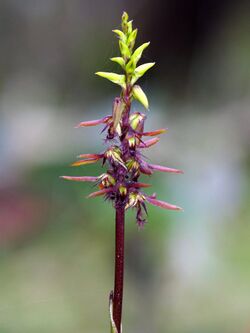Biology:Genoplesium morrisii
| Bearded midge orchid | |
|---|---|

| |
| Scientific classification | |
| Kingdom: | Plantae |
| Clade: | Tracheophytes |
| Clade: | Angiosperms |
| Clade: | Monocots |
| Order: | Asparagales |
| Family: | Orchidaceae |
| Subfamily: | Orchidoideae |
| Tribe: | Diurideae |
| Genus: | Genoplesium |
| Species: | G. morrisii
|
| Binomial name | |
| Genoplesium morrisii (Nicholls)D.L.Jones & M.A.Clem.
| |
| Synonyms[1] | |
| |
Genoplesium morrisii, commonly known as the bearded midge orchid and known as Corunastylis morrisii in Australia, is a small terrestrial orchid endemic to south-eastern Australia. It has a single thin leaf fused to the flowering stem and up to fifteen small, dark purplish-black or green and purple flowers.
Description
Genoplesium morrisii is a terrestrial, perennial, deciduous, herb with an underground tuber and a single thin leaf 200–250 mm (8–10 in) long and fused to the flowering stem with the free part 10–22 mm (0.4–0.9 in) long. Between three and fifteen dark purplish-black or green and purple flowers are crowded along a flowering stem 35–50 mm (1–2 in) tall. The flowers are about 11 mm (0.4 in) long and 9 mm (0.4 in) wide and are inverted so that the labellum is above the column rather than below it. The dorsal sepal is egg-shaped, 5–6 mm (0.20–0.24 in) long and about 2.5 mm (0.1 in) wide with dark purpish-black stripes. The lateral sepals are linear to lance-shaped, about 7 mm (0.3 in) long, 1.5 mm (0.06 in) wide and spread apart from each other. The petals are lance-shaped to egg-shaped, about 4 mm (0.2 in) long and 1.5 mm (0.06 in) wide with a pointed tip. The labellum is lance-shaped, to narrow egg-shaped, about 4 mm (0.2 in) long, 1.5 mm (0.06 in) wide and vibrates in the slightest breeze. The sides of the labellum are lines with many coarse, spreading cilia and there is a narrow oblong callus in the centre of the labellum and extending about half way to its tip. Flowering occurs between January and April.[2][3][4]
Taxonomy and naming
The bearded midge orchid was first formally described in 1931 by William Henry Nicholls who gave it the name Prasophyllum morrisii and published the description in The Victorian Naturalist.[5][6] In 1989, David Jones and Mark Clements changed the name to Genoplesium morrisii[7] and in 2002 changed the name again to Corunastylis morrisii.[8] The specific epithet (morrisii) honours "Mr. P.F. Morris of the National Herbarium, whose name I have bestowed upon this dainty little species".[6]
Distribution and habitat
Genoplesium morrisii grows in forest, woodland and heath and is widespread and common in the southern half of Victoria. It is rarely encountered in Tasmania and possibly grows in the far south-east of New South Wales.[2][3][9]
Conservation
Corunastylis morrisii is classed as "Endangered" under the Tasmanian Threatened Species Protection Act 1995. It is only known from a few near-coastal areas in the north and south where fewer than 100 mature plants are thought to survive. The main threats to the species in Tasmania are land clearing, inappropriate fire regimes and inappropriate disturbance.[10]
References
- ↑ "Genoplesium morrisii". World Checklist of Selected Plant Families (WCSP). Royal Botanic Gardens, Kew. http://wcsp.science.kew.org/namedetail.do?name_id=89176.
- ↑ 2.0 2.1 Jones, David L. (2006). A complete guide to native orchids of Australia including the island territories. Frenchs Forest, N.S.W.: New Holland. p. 177. ISBN 1877069124.
- ↑ 3.0 3.1 Jeanes, Jeff. "Corunastylis morrisii". Roya Botanic Gardens Victoria. https://vicflora.rbg.vic.gov.au/flora/taxon/6ea1b45b-8889-44a4-b46b-c1637a70db10. Retrieved 22 January 2018.
- ↑ Jones, David L.. "Genoplesium morrisii". Royal Botanic Garden Sydney. http://plantnet.rbgsyd.nsw.gov.au/cgi-bin/NSWfl.pl?page=nswfl&lvl=sp&name=Genoplesium~morrisii. Retrieved 22 January 2018.
- ↑ "Prasophyllum morrisii". APNI. https://id.biodiversity.org.au/instance/apni/534882. Retrieved 22 January 2018.
- ↑ 6.0 6.1 Nicholls, William Henry (1931). "A revision of certain species of the genus Prasophyllum R.Br.". The Victorian Naturalist 48: 108–109. https://www.biodiversitylibrary.org/item/125544#page/112/mode/1up. Retrieved 22 January 2018.
- ↑ "Genoplesium morrisii". APNI. https://id.biodiversity.org.au/instance/apni/473721. Retrieved 22 January 2018.
- ↑ "Corunastylis morrisii". APNI. https://id.biodiversity.org.au/instance/apni/581188. Retrieved 22 January 2018.
- ↑ Jones, David L. (1998). "A taxonomic revies of Genoplesium in Tasmania". Australian Orchid Research 3 (5): 89.
- ↑ "Threatened species listing statement - Corunastylis morrisii". Government of Tasmania Department of Primary Industries, Parks, Water and Environment. http://www.naturalvaluesatlas.tas.gov.au/downloadattachment?id=13664. Retrieved 22 January 2018.
External links
Wikidata ☰ Q15463355 entry
 |

